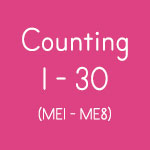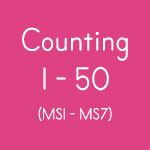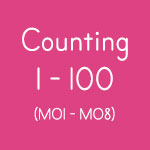Counting Curriculum
1. Overview
Our math curriculum is a made up of 40 short and simple games that you can play with your children. Each game builds slightly on the last, taking your children from beginners to promising mathematicians.
Children who complete the curriculum will have a strong foundation for counting and will be ready to start basic addition and subtraction.
2. Games
The following 40 games form our basic math curriculum. Through exciting games, children will build on skills they learned from previous games to learn new concepts. At the same time, children will practice previous lessons to build a strong foundation.
3. Lesson Plans & Sequence
Each lesson takes about 20 minutes and works best when taught to children individually or in small groups (2-5 children). For each lesson, play one new game and at least one old game. Repeat each game as many times as you can. Even when you think your child has mastered an activity, continue playing it a few times to build a strong foundation.
Once activities are mastered, it is important to return to those games and activities periodically for a little review. Doing so helps children retain and practice learned skills and boost their confidence as they learn new skills. The curriculum we have laid out follows the general development of math skills. So it is best to follow this sequence in teaching children. However, once the skills have been mastered, you can review activities in any order you choose.
4. Confidence Builders & Extensions
Every child is different and will move through our curriculum at a different pace. A child who breezes through the Number Puzzles may struggle with Number Matching, while another child will struggle with the Number Puzzles but master Number Matching very quickly.
Many of our activity pages have recommendations on how to match the activity level to the needs of your particular child. Confidence Builders make the game a little easier for struggling students. Extensions offer extra challenges for children who have already mastered the main activity.
These tools for scaffolding and scaling can be used with groups of children if some are more advanced and others need extra help.
5. Frequently Asked Questions
Q: How old does my child need to be before I start teaching him math?
A: The Math curriculum is generally recommended for children who are three to five years old. Some of the most basic counting activities can be done with a child as young as two, but only if the child is willing to learn.
Q: How long will it take to go through the entire Math curriculum?
A: This depends on your particular child or group of children. On average, if your children start early (around 2 to 3), then they should be adding before kindergarten. For four-year-olds, the average time is 10 to 12 months.
Q: I’m a teacher. How long will it take to get my students back up to speed after summer vacation?
A: Encourage the students’ parents to go to our website and play math games with the kids over vacation. Each activity only takes a few minutes, but not all parents will do it. Plan to spend up to one month at the beginning of the school year reviewing material from the spring. Remember, we are building a foundation, and we want to be sure that foundation is solid. Once you’re sure the kids have retained (or re-learned!) last year’s material, start introducing brand new activities.
Leave a Reply








3 Responses to “Counting Curriculum”
Caroline
I am thrilled to have found your website! I am an experienced teacher, but new to the preschool level and this is just perfect for me to understand the learning sequence. I also live in Costa Rica and do not have access to materials so the ability to download and print is a life saver! Not to mention that the materials are free, Incredible!!
Thank you so much!!
Debbie
Hi there! “Counting 1-50” is missing the 7th game, while “Counting 1-100” is missing the 8th game. Can you please post them? Thank you so much! 🙂
Ettina
I’ve been doing this curriculum for a few months with my 2yo, and she loves it! She’s now obsessed with trying to count everything!